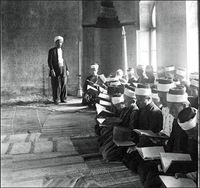Ethiopian Traditional Education.
INDIGENOUS KNOWLEDGE IS BEYOND MODERNITY
Ge’ez, or Classical Ethiopic, is one of the ancient world’s major literary languages, with two millennia of history in the Horn of Africa and Arabia. The language appears in many ancient inscriptions and in Jewish and Christian writings, even shaping the language of the Qur’an and early Muslim religious texts. It continues to live on today as the liturgical language of the Ethiopian and Eritrean Orthodox churches.
For several thousand years religion controlled education in Ethiopia. The ancient Axumites created a system of writing that evolved from a Sabean script believed to have been introduced from Arabia. Similar to written Hebrew and related to Phoenician, the system is phonetic. The ancient Ge'ez language descended from such origins. Stone monoliths record the daring feats of ancient kings in Ge'ez, which has been the liturgical language of Ethiopia's Jews for 3,000 years and the Ethiopian Coptic Christian church since A.D. 400. This language was developed by a sophisticated ancient civilization and used not only by priests, but also by rulers who created impressive stone palaces, temples, and tombs, like the obelisks found at Aksum. Writings in Ge'ez, as well as Greek and Sabean, inscribed on these monuments describe military campaigns, the victories of Ethiopian kings, and trade with Arabia, Egypt, Syria, Greece, and India. Gold and silver coins were minted to facilitate commerce and trade.
Key findings
- The church and the mosque were the institutions that provided education long before the introduction of modern schools into Ethiopia. The Ethiopian Orthodox Church developed and spread a system of learning in ancient Geez language and later on in Amharic.
- Many findings revealed that, native age old church schools played a significant role in the development of adult education; and have also a good implication on the improvement of modern education qualities in Ethiopia. traditionally,
- In Ethiopia, there are thousands of indigenous church schools that have been active for over a thousand years and offer a wide range of education from primary to higher education. In relation to this, considered that the number of Ethiopian indigenous schools was not known, but modest estimates suggest that there are about 30,000 to 35,000 traditional schools still existing in the country. For ages, these schools have served as a center for learning knowledge, skills, the arts, and ancient history. These schools were the sources of all knowledge and wisdom in the country. The schools were also playing a significant role in spreading literacy among Ethiopians during a time when modern education had not yet been implemented, notably before 1908. Reading and writing abilities, arithmetic, art, architecture, law, governance, medicine, and other skills and knowledge were taught in traditional church schools.
These schools have been institutes of architectural, governance, leadership, philosophy, law, and other societal development skills, and the teaching style of the schools is among the heritage found in the Ethiopian Orthodox Church’s traditional schools. - The most important foundation of Ethiopian philosophy of education is church education which constitutes a highly elaborated system of education which imparts the knowledge of reality, existence and human values to students. Furthermore, one also needs to understand traditional societal customs and values and their role in educating the youth. As such, traditional wisdom “ is philosophical in the sense that it constitutes part of a world view or set of beliefs that underpin everyday living”
- Ge-ez is believed to be the repository of all rounded achievements for Ethiopians for centuries, Thus, it help the nation in the production of citizens who are capable of interpreting, enriching, adapting and synthesizing the heritages of the country to the new needs, new problems and situations. Students by deciphering such achievements by immersing themselves in the language of their antecedents that Ge-ez preferred to be medium of instruction.
We believe the exclusion of Ethiopia’s rich traditions in modern education is a fundamental reason for the failure of education to improve the lives of the majority in the country.
Ge-ez Today
In today’s world, there is a greater awareness that there is an intimate relation between conceptions of knowledge on one hand and power relations and ideological frameworks on the other. Such assumptions also extend to language itself. Rather than only exploring language focused on cognitive and propositional truth and medium for communication,
Recently , Many American universities and other educational institutions around the globe started offering Geez language. America's Harvard, Cambridge University Faculty of Divinity, Germany's Hamburg, Italy's Carmine, Catholic University Aaron M. Butts ,...etc teach Geez as their native language. Ethiopians believe that Geez language is not made by man, but rather it is a special treasure given to us by the creator to know the secret of this universe, that can serve for research, for the study of space, the sky - the moon and the stars, for the earth's cycle and stability, for medicine. We throw it away, But those who understood well the value of this ancient language they pick it up and decorate it. This is it.
Historical data Islamic traditional Education.
